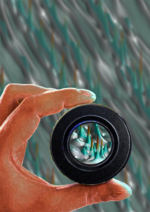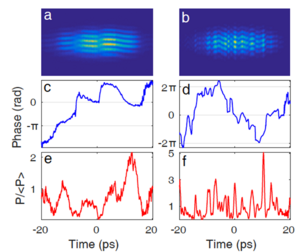2) Turbulence Intégrable et Gaz de Solitons
Les recherches s’inscrivent dans le cadre de l'optique statistique non linéaire et de la turbulence optique. Plus précisément, nous nous concentrons sur les phénomènes fondamentaux de la turbulence intégrable. Les équations intégrables telles que l’équation de Korteweg-de-Vries (KdV), l'équation de Schrödinger non linéaire à une dimension (1DNLSE) ou l'équation de Sine-Gordon sont des modèles universels décrivant divers systèmes d'onde non linéaires à l'ordre principal. Ces équations aux dérivées partielles (EDP) sont parfaitement intégrables et peuvent être étudiées par la technique dite « inverse scattering transform » (IST), également appelée transformation de Fourier non linéaire. Ces EDP présentent des propriétés remarquables telles que la propagation de solitons. La turbulence intégrable correspond aux phénomènes complexes émergeants au cours de la propagation d’ondes aléatoires (partiellement cohérentes) dans des systèmes intégrables. V.E. Zakharov a présenté ce nouveau domaine de recherche fondamental comme un tout nouveau chapitre de la théorie de la turbulence [1]. La turbulence intégrable est de nature profondément différente de la turbulence d'onde standard car les EDP intégrables sont caractérisées par une hiérarchie infinie d'invariants et les interactions d'ondes sont non résonantes [2,3] Dans notre groupe, nous étudions expérimentalement, numériquement et théoriquement les phénomènes de turbulence intégrable. Nos expériences, notamment réalisées dans les fibres optiques, ont permis de mettre en évidence diverses signatures remarquables de turbulence intégrable telles que l’émergence de statistiques non gaussiennes, la génération de solitons de Peregrine au cours de la propagation d’ondes aléatoires ou le phénomène d’intermittence. En collaboration avec le groupe "Sources de rayonnement synchrotron cohérent" du Phlam, nous avons développé des techniques de mesure ultra rapide permettant l’études d’ondes optiques partiellement cohérentes ayant des échelles de temps sub-picosecondes. L’une de nos contributions les plus remarquables est la mesure ultra-rapide de la phase et de l’amplitude des ondes aléatoires non linéaires se propageant dans les fibres optiques.
[1] Zakharov, V. E. Stud. Appl. Math. 122, 219–234 (2009)
[2] Suret, P., Picozzi, A. & Randoux, S. Opt. Express 19, 17852–17863 (2011)
[3] Picozzi, A. et al. Phys. Rep. 542, 1 – 132 (2014).
Group
Pierre SURET (Professor)
Stéphane RANDOUX (Professor)
François COPIE (assistant Professor)
Alexey TIKAN (Postdoc)
Adrien KRAYCH (PhD)
Alexandre LEBEL (PhD)
Giacomo ROBERTI (PhD)
Page en attente de traduction / Page awaiting translation
a) Ultrafast measurement of optical turbulence

Artistic view designed by Anastasia Lukina
Measurement of statistics
We have developed an asynchronous optical sampling setup that enables the precise measurement of the probability density function (PDF) of optical power rapidly fluctuating with time (subpicosecond time scale) [1]. We propagate partially coherent waves in single mode fibers in the anomalous (focusing) or normal (defocusing) regime of dispersion. In the focusing regime, the PDF is found to evolve from the normal law to a strong heavy-tailed distribution, thus revealing the formation of rogue waves in integrable turbulence. In the defocusing regime, the PDF becomes low tail distribution that corresponds to the emergence of dispersive shock waves in integrable turbulence [2,3].
[1] P. Walczak, S. Randoux and P. Suret, Optical rogue waves in integrable turbulence Phys. Rev. Lett., 114, (14), 143903, (2015)
[2] S. Randoux, P. Walczak, M. Onorato and P. Suret, Physica D : Nonlinear Phenomena, 333, (2016)
[3] S. Randoux and P. Suret, Chapter in Rogue and Shock Waves in Nonlinear Dispersive Media, (2016)
Single-shot Measurement of phase and amplitude
In collaboration with the “group “Coherent synchrotron radiation sources” of the PhLAM, we have designed and developed a time microscope ultrafast acquisition system that enables the direct single-shot recordings of sub-picosecond optical rogue waves [1]. Ultrafast structures having peak powers much larger than the average optical power are generated from the propagation of partially coherent waves in optical fibre and are recorded with 250 femtoseconds resolution. Our experiment has demonstrated the central role played by ‘breather-like’ structures such as the Peregrine soliton in the emergence of heavy-tailed statistics in integrable turbulence.
Our original setup is not a standard time lens. It uses an analogous in the temporal domain of a microscope and the final signal is record by one horizontal line of a sCMOS camera whereas standard time lens setups use photodiode. This characteristic has two important consequences: first the signal/noise ratio is extremely good (dynamical range up to 40dB) and secondly, the vertical axis of the camera may be used to record other information such as the phase (see below [2]).

Fig. extracted from Nature Photonics, 12, (4), 228, (2018) : Phase, amplitude and spectrum of partially coherent waves (ASE) recorded with our heterodyne time microscope. The width of the (average) optical spectrum of the partially coherent light waves is adjusted by using a programmable filter. Results correspond to = 0.1 THz (a,c,e) and = 0.7 THz (b,d,f).
In our recent Nature Photonics paper [2], we report a new heterodyne time-lens arrangement that efficiently records both the amplitude and phase of complex and random signals over large temporal windows (tens of picoseconds). Phase and time are encoded onto the two spatial dimensions of a camera. We implement this phase-sensitive time-lens system in two configurations: a time microscope and a digital temporal-holography device (SEAHORSE) that enables single-shot measurement with a temporal resolution of ~80 fs. The starting point of this work is the time microscope reported previously (El Koussaifi et al. Nat. Commu., 2016, see above) in which we use the vertical axis of the camera. The phase is encoded in a spatial arrangement by using the reference between the complex signal and a monochromatic reference. In the SEAHORSE arrangement, we remove the dispersive element applied to the signal in the standard time lens devices. As a consequence, the aberrations always induced by high order dispersion in time lenses are strongly reduced. This allows us to achieve phase and amplitude measurement with a 80 fs resolution whereas standard time lens only record the amplitude with resolution larger than 250fs. Our observations have unveiled the special evolution of the phase (and amplitude) of rogue waves in integrable turbulence (see below)
[1] P. Suret, R. El Koussai, A. Tikan, C. Evain, S. Randoux, C. Szwaj and S. Bielawski, Single-shot observation of optical rogue waves in integrable turbulence using time microscopy, Nature Communications, 7, 13136 (2016)
Highlights :
- CNRS News, Observer des ondes lumineuses scélérates sur des temps ultra-courts, Les Actualités scientifiques de l’Institut de Physique du CNRS, 13 avril 2017
- [2] A. Tikan, S. Bielawski, C. Szwaj, S. Randoux and P. Suret, Single-shot measurement of phase and amplitude by using a heterodyne time-lens system and ultrafast digital time-holography, Nature Photonics, 12, (4), 228, (2018)
- News &Views Nature Photonics: Cheng Lei and Keisuke Goda, The complete optical Oscilloscope, Nat. Photon., 12, pp190–191 (2018)
- CNRS News: Mesurer à la fois l’intensité et la phase d’un signal optique unique avec une grande résolution et sur une large fenêtre temporelle, Actualités de l’Institut de Physique, 5 Octobre 2018, http://www.cnrs.fr/inp/spip.php?article6179
b) Experiments in integrable turbulence
Recent optical fiber experiments performed in our group have contributed to demonstrate that ubiquitous phenomena typifying many hydrodynamical experiments can be also observed in the context of integrable turbulence or more generally, in wave systems described by nonlinear evolution equations having an integrable core part. For instance, we have made optical fiber experiments revealing that the intermittency phenomenon (i.e. the departure from the Gaussian statistics that grows increasingly from large scales to small scales in a turbulent field) extensively studied in the context of hydrodynamical turbulence has been observed in an optical fiber experiment well described by the defocusing one-dimensional nonlinear Schrodinger equation (NLSE) [1].
Our experimental works have also addressed the question of nonlinear focusing of random optical waves. Using an optical sampling method, we have precisely measured the probability density function of partially coherent optical waves propagating in single mode fibers (focusing regime/anomalous dispersion). We have observed heavy-tailed deviations from the initial gaussian statistics, thus demonstrating the formation of optical rogue waves in the context of integrable turbulence [2]. Implementing a time microscope, we have been able to allocate the observed statistical features to the generation of Peregrine-like breathers from the nonlinear evolution of the initial random field [3,4].
Our experimental results have also contributed to show the physical relevance of the so-called semiclassical regime of the focusing NLSE. In particular, we have realized optical fiber experiments in which we have analyzed the gradient catastrophe that emerges in the context of propagation of higher-order solitons. Our measurements of temporal focussing of high power pulses have revealed the occurrence of a robust and universal mechanism that yields the Peregrine soliton structure over a broad range of parameters [5].
Using a dispersive-hydrodynamic approach (semiclassical regime of the defocusing NLSE), we have shown that the development of integrable turbulence can be divided into two distinct stages, the initial, pre-breaking stage being described by a system of interacting random Riemann waves. We have shown that the Riemann invariants of the asymptotic nonlinear geometric optics system represent the observable quantities that provide new insight into statistical features of the initial stage of the integrable turbulence development by exhibiting stationary probability density functions [6].
We have made an optical fiber experiment that build a bridge between one-dimensional nonlinear random waves in optics and in hydrodynamics. An optical fiber experiment has been devised in order to properly reproduce the statistical properties of gravity waves measured in a long wave tank with initial conditions characterized by a JONSWAP spectrum and random phases. Our results have demonstrated some universal features of rogue waves [7].
- S. Randoux, P. Walczak, M. Onorato and P. Suret; Intermittency in Integrable Turbulence; Phys. Rev. Lett. 113, 113902 (2014)
- P. Walczak, S. Randoux and P. Suret; “Optical Rogue Waves in Integrable Turbulence” ; Phys. Rev. Lett. 114, 143903 (2015)
- P. Suret, R. El Koussaiffi, A. Tikan, C. Evain, S. Randoux, C. Szwaj and S. Bielawski; “Single-Shot Observation of Optical Rogue Waves in Integrable Turbulence Using Microscopy”; Nature Comm. 7, 13136 (2016)
- A. Tikan, S. Bielawski, C. Szwaj, S. Randoux, P. Suret; “Single-shot measurement of phase and amplitude by using a heterodyne time-lens system and ultrafast digital time-holography”, Nature Photonics 12, 228 (2018)
- A. Tikan, C. Billet, G. El, A. Tovbis, M. Bertola, T. Sylvestre, F. Gustave, S. Randoux, G. Genty, P. Suret, J. M. Dudley; “Universality of the Peregrine Soliton in the focusing dynamics of the cubic nonlinear Schrödinger equation”; Phys. Rev. Lett. 119, 033901 (2017)
- Stéphane Randoux, Francois Gustave, Pierre Suret and Gennady El; “Optical Random Riemann Waves in Integrable Turbulence”, Physical Review Letters, 118, 23 (2017)
- R. El Koussaiffi, A. Tikan, A. Toffolli, S. Randoux, P. Suret, M. Onorato; “Spontaneous emergence of rogue waves in partially coherent waves: a quantitative experimental comparison between hydrodynamics and optics”, Phys. Rev. E 97, 012208 (2018)
c) Theoretical questions
Integrable partial differential equations such as the 1D-NLSE can be solved by using the inverse scattering transform (IST) method. In recent years, we have developed and used numerical IST tools to analyze breather like structures found in numerical and experimental data [1]. Using this approach we have extended the existing classifications of the prototypes of rogue waves from standard breathers and their collisions to more general nonlinear modes characterized by their nonlinear spectra. In particular nonlinear spectral analysis of the breathers observed in recent optical fiber and water tank experiments has revealed that these breathers exhibit spectral portraits associated with general, genus 4 finite-gap 1D-NLSE solutions [2].
- S. Randoux, P. Suret and G. El; “Inverse scattering transform analysis of rogue waves using local periodization procedure”; Scientific Report 6, 29238 (2016)
- S. Randoux, P. Suret, A. Chabchoub, B. Kibler and G. El; Nonlinear spectral analysis of Peregrine solitons observed in optics and in hydrodynamic experiments, Phys. Rev. E, 98,022219 (2018)
